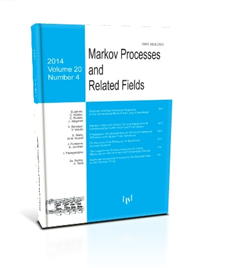Parrondo Games with Spatial Dependence and a Related Spin System, II
S.N. Ethier, Lee Jiyeon
2013, v.19, Issue 4, 667-692
ABSTRACT
Let game $B$ be Toral's cooperative Parrondo game with (one-dimensional) spatial dependence, parameterized by $N\ge3$ and $p_0,p_1,p_2,p_3\in[0,1]$, and let game $A$ be the special case $p_0=p_1=p_2=p_3=1/2$. Let $\mu_B^N$ (resp., $\mu_{(1/2,1/2)}^N$) denote the mean profit per turn to the ensemble of $N$ players always playing game $B$ (resp., always playing the randomly mixed game $(1/2)(A+B)$). In previous work we showed that, under certain conditions, both sequences converge and the limits can be expressed in terms of a parameterized spin system on the one-dimensional integer lattice. Of course one can get similar results for $\mu_{(\gamma,1-\gamma)}^N$ corresponding to $\gamma A+(1-\gamma)B$ for $0<\gamma<1$. In this paper we replace the random mixture with the nonrandom periodic pattern $A^r B^s$, where $r$ and $s$ are positive integers. We show that, under certain conditions, $\mu_{[r,s]}^N$, the mean profit per turn to the ensemble of $N$ players repeatedly playing the pattern $A^rB^s$, converges to the same limit that $\mu_{(\gamma,1-\gamma)}^N$ converges to, where $\gamma:=r/(r+s)$.
Keywords: Parrondo's paradox,cooperative Parrondo games,discrete-timeMarkov chain,stationary distribution,strong law of large numbers,interacting particle system,spin system,ergodicity
COMMENTS
Please log in or register to leave a comment

